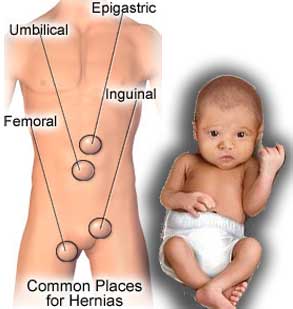Femoral hernia occurs in the groin area. It is more common in women and typically affects individuals over the age of 50. This blog post will provide a comprehensive overview of femoral hernias, including their types, causes, symptoms, diagnosis, complications, home remedies, and answers to frequently asked questions.

Types of Femoral Hernia
These sneaky protrusions in the groin, may appear harmless, but don’t be fooled. These less common cousins of inguinal hernias come in different types, each with its own story and potential risks. Let’s delve into their world, understanding their quirks and recognizing the warning signs.
1. The Shy Intruder: Simple Femoral Hernia
Imagine a mischievous loop of intestine, a stealthy traveler, poking through a weak spot near your groin. This “simple femoral hernia” is the most common culprit, forming a noticeable bulge in your upper thigh, especially when you stand or strain. While initially pain-free, this silent adventurer can grow bigger over time, causing discomfort and urging a friendly chat with your doctor.
2. The Trapped Troublemaker: Incarcerated Femoral Hernia
Things get dramatic when our intestinal traveler gets stuck, trapped in the femoral canal like a lost explorer. This “incarcerated hernia” throws a party of nausea, vomiting, and severe pain, a clear sign that things need to get unstuck. Delaying the rescue mission, i.e., seeking medical attention, can lead to intestinal blockage, a scenario no one wants on their itinerary.
3. The Ticking Time Bomb: Strangulated Femoral Hernia
This is the villain you never want to meet. In a “strangulated femoral hernia,” the trapped tissue loses its blood supply, like a forgotten candle in a dark cave. This can lead to tissue damage and even gangrene, a scary consequence requiring immediate surgery. Remember, early diagnosis and treatment are the heroes against this emergency, preventing the situation from escalating.
Beyond the Big Three:
While these three types steal the spotlight, the world of femoral hernias has other characters. There’s the prevascular hernia, where the tissue peeks out before the femoral vessels like a curious child, and the Littre hernia, a rare encapsulated diverticulum herniating through the canal. Regardless of their names and appearances, any suspicious bulge or discomfort in the groin or upper thigh deserves a doctor’s visit.
Unmasking the Mystery: Your Role in Diagnosis
Knowledge is power, and when it comes to your health, it’s your ultimate weapon. Recognizing the different faces of femoral hernias empowers you to be your own detective. Notice a bulge? Feeling pain? Don’t wait for the plot to twist. Consult your doctor, understand the type of hernia you’re facing, and together, write a happy ending to this story.
Remember, the world of femoral hernias, though diverse, shouldn’t be navigated alone. Early detection and proper treatment are the keys to a smooth journey, ensuring you can continue your adventures without any unwanted companions.
Causes of Femoral Hernia
Several factors contribute to the development of femoral hernias:
Weakness in the abdominal wall: Weakness in the lower abdominal muscles can create an opening for organs or tissues to push through, resulting in a hernia.
Increased pressure in the abdomen: Conditions that cause increased pressure in the abdomen, such as obesity, pregnancy, chronic cough, or constipation, can increase the risk of developing a femoral hernia.
Congenital predisposition: Some individuals have a genetic predisposition to develop hernias due to inherent weakness in their connective tissues.
Symptoms of Femoral Hernia
Femoral hernias often present with the following symptoms:
A lump or bulge in the groin or upper thigh area that may be more prominent when standing or straining.
Discomfort or pain in the groin area that may worsen with physical activity or lifting heavy objects.
Nausea or vomiting, which may occur if the herniated tissue becomes trapped and its blood supply is compromised.
Groin area pressure or a having a feeling of heaviness
Diagnosis of Femoral Hernia
To diagnose a femoral hernia, healthcare professionals may perform the following:
Physical examination: A thorough examination of the groin area allows doctors to identify any bulges or lumps that indicate a hernia.
Medical history review: Understanding a patient’s medical history helps identify risk factors that may contribute to hernia development.
Imaging tests: Ultrasound and MRI scans can help provide a detailed view of the hernia and surrounding structures to confirm the diagnosis.
Diagnostic laparoscopy: In some cases, a minimally invasive procedure called laparoscopy may be performed to directly visualize the hernia and determine its severity.
Complications of Femoral Hernia
If left untreated, femoral hernias can lead to various complications:
1. Incarceration
Incarceration occurs when a portion of the intestine or other abdominal contents becomes trapped within the hernia sac. This may result in severe pain, nausea, vomiting, and bowel obstruction. Immediate medical attention is necessary to prevent further complications.
2. Strangulation
Strangulation is a serious complication that occurs when the blood supply to the herniated tissue is cut off. It can lead to tissue death (gangrene) and requires emergency surgery to prevent life-threatening consequences.
Home Remedies for Femoral Hernia
While surgical intervention is often necessary to repair a femoral hernia, some home remedies may help alleviate symptoms and support recovery:
Avoid strenuous activities that could worsen the hernia.
Apply ice packs or cold compresses to reduce swelling and relieve pain.
Wear a supportive abdominal binder or truss to provide gentle compression and support to the affected area.
Follow a high-fiber diet to prevent constipation and reduce strain during bowel movements.
Treatment For Femoral Hernia
A thorough physical examination by a qualified physician is the first step in diagnosing a femoral hernia. Imaging tests like ultrasound or CT scans may be utilized to confirm the diagnosis and assess the severity of the condition. Early and accurate diagnosis is crucial for determining the most appropriate treatment course.
Treatment Options: Repairing the Weak Point
Depending on the size, location, and severity of the hernia, various treatment options exist.
Observation: For small, asymptomatic hernias that exhibit minimal growth, a watchful approach with regular checkups may be recommended. This is a conservative strategy for individuals who prefer non-invasive methods.
Surgical Repair: This is the definitive treatment for most femoral hernias. Laparoscopic surgery, a minimally invasive approach utilizing small incisions and a camera, is often preferred for faster recovery and reduced scarring. Open surgery, while more invasive, may be necessary for larger or complex hernias. Both procedures involve reinforcing the weakened area in the abdominal wall to prevent future herniation.
Recovery and Prognosis:
Following any surgical intervention, a period of rest and recuperation is necessary. Adhering to the prescribed activity restrictions and wound care instructions is crucial for optimal healing. In most cases, the prognosis for femoral hernia repair is excellent with a low risk of recurrence.
Living with a Femoral Hernia:
While successful repair addresses the immediate issue, long-term strategies to maintain abdominal wall strength can help prevent reoccurrence. These may include managing chronic conditions like constipation or cough, maintaining a healthy weight, and adopting proper lifting techniques.
Remember: Femoral hernias should not be ignored. Early diagnosis and appropriate treatment are key to preventing complications and ensuring a successful outcome. Consult your physician promptly if you notice any bulge or discomfort in the groin area.
Life And Outlook During Recovery
The outlook after femoral hernia repair is generally excellent, with most people living comfortably and without recurrence. This generally is how recovery in most cases happens :
Recovery Route:
Initial stage (1-2 weeks): Expect some tenderness and discomfort around the incision site. Rest well, follow your doctor’s pain management instructions, and avoid strenuous activity. One can safely resort to mild walking and some stretching.
Intermediate stage (2-4 weeks): You’ll gradually regain strength and mobility. Slowly increase your activity level, but listen to your body and avoid lifting heavy objects.
Final stage (4-8 weeks): Most people return to their normal activities by this point. You should feel significantly stronger and less restricted. Regular exercise and maintaining a healthy weight can help prevent future hernias.
Life After Repair:
Scarring: Laparoscopic surgery usually leaves minimal scarring, while open surgery might result in a longer scar that fades over time.
Activity: Enjoy physical activities again! However, consult your doctor about any high-impact sports or heavy lifting to ensure proper healing and prevent recurrence.
Complications: Risks from surgery are rare, but like any procedure, infection or bleeding can occur. Be vigilant about any unusual symptoms and report them to your doctor promptly.
Remember: Each recovery journey is unique. While this provides a general timeline, listen to your body, follow your doctor’s instructions, and don’t hesitate to ask questions.
Conclusion
Femoral hernias are a specific type of hernia that require prompt medical attention to avoid potential complications. Understanding the types, causes, symptoms, diagnosis, complications, home remedies, and frequently asked questions surrounding femoral hernias can help individuals make informed decisions about their health and seek appropriate treatment when needed.
Frequently Asked Questions (FAQs)
Q1: Can a femoral hernia go away on its own?
A1: No, femoral hernias do not resolve on their own and typically require surgical repair.
Q2: Is it necessary to have surgery for a femoral hernia?
A2: Yes, surgical intervention is generally recommended to repair a femoral hernia and prevent potential complications.
Q3: How long does recovery take after femoral hernia surgery?
A3: Recovery time varies depending on individual factors and surgical approach but generally ranges from a few weeks to several months.
Q4: Can I exercise with a femoral hernia?
A4: It is essential to consult with a healthcare professional before engaging in any physical activity if you have a femoral hernia.
Q5: Can I prevent a femoral hernia from occurring?
A5: While it may not be possible to prevent all cases of femoral hernias, maintaining a healthy weight, avoiding excessive strain during bowel movements, and practicing proper lifting techniques can help reduce the risk.
Reference : http://www.wikipedia.com







